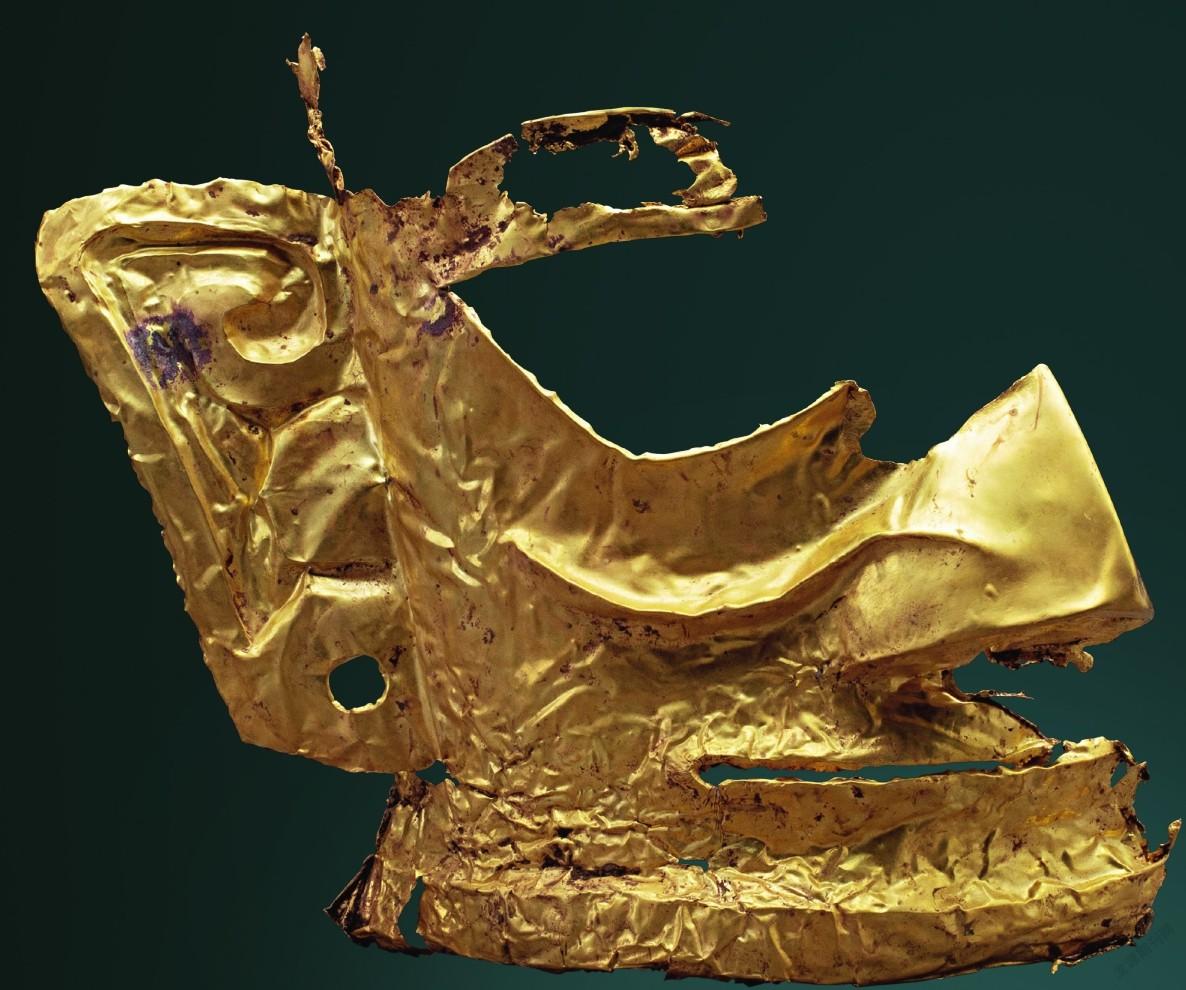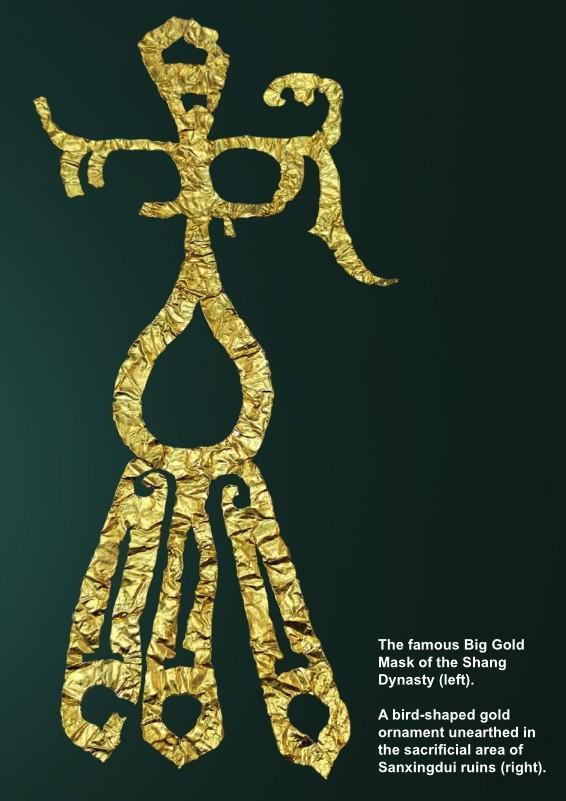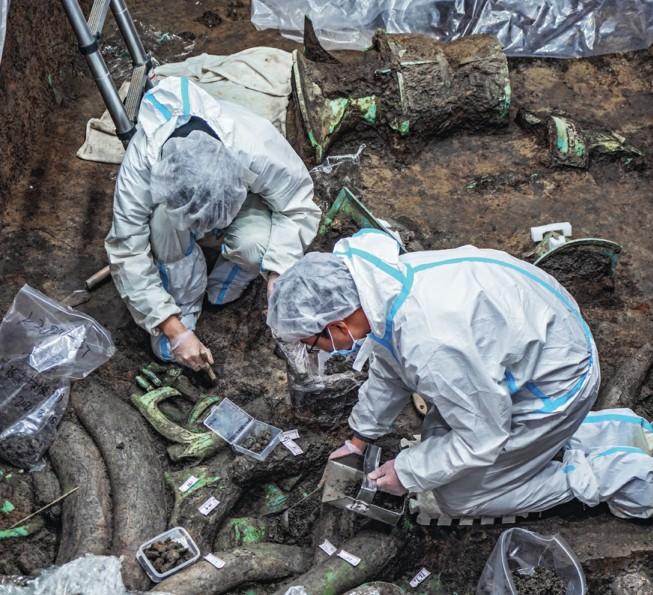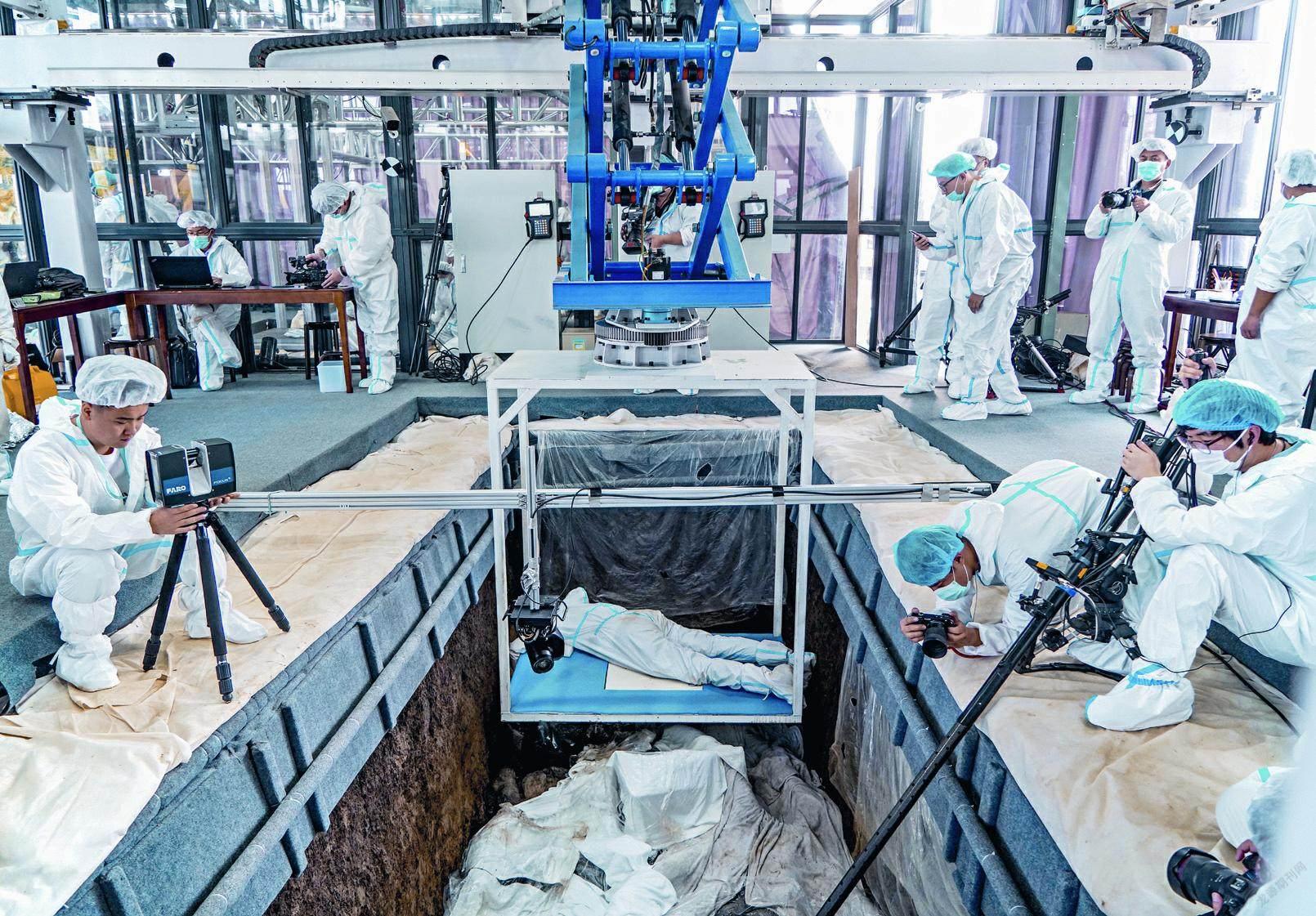More Ancient Sanxingdui Discoveries Amaze the World
By WU XIAOLING, WU MENGLIN & LI TING

ON March 20, 2021, the latest archaeological discovery at the Sanxingdui ruins site gripped the public’s attention: more than 500 ancient artifacts were unearthed in the six newly discovered sacrificial pits, including a bronze portrait with painted eyes, a gold mask, and a bronze holy tree sculpture. After 34 years since the last finds, these new items become part of the Sanxingdui collection.
The Sanxingdui ruins site sits on the south bank of the Yazi River in Guanghan City, Sichuan Province, spanning around 12 square kilometers and dating back between 3,000 and 5,000 years. Its core area is the ancient city of Sanxingdui, which occupies about 3.6 square kilometers. The Sanxingdui ruins are known as one of the greatest archaeological discoveries of humankind in the 20th century. Its discovery was full of surprises, but also left many mysteries. Thanks to close to 100 years of excavation, those mysteries are being unveiled one after another.

Gold Foil Surprise
The gold mask was found in Pit No. 5. Among the six sacrificial pits which were excavated this time round, Pit No. 5 is the smallest in size, but its uniqueness and importance became apparent soon after the excavation work began.
The Sichuan Provincial Cultural Relics and Archaeology Institute (SPCRAI) and the School of Archaeology and Museology with the Sichuan University jointly worked on the excavation of No. 5, 6, and 7 sacrificial pits. “In early December last year, we started excavations in the sacrificial area. Pit No. 5 opening was 30 to 40 cm deep below the surface,”said Li Yuniu, a member of the excavation team from Sichuan University. He witnessed the discovery of the gold mask.
Li said ancient artifacts were first discovered when they reached 50 cm beneath the surface. What appeared at first were some small perforated gold discs, and then a large number of white and gray-black splinters, which were later identified as ivory through composition analysis and other testing methods, Li said. After that, a relatively large piece of gold foil was found southwest of the center of Pit No. 5. Li recalled that at first, no one thought much of the discovery, but after careful excavation around the foil, more of its form was revealed, contrasting sharply with the small gold discs and ivory splinters that lay scattered around it.
Amid much mounting excitement, the gold foil had been fully revealed by early January this year. It looked like just a crumpled piece of gold foil to most people, but experienced experts immediately identified it as a gold mask. “The reason for this inference is that several gold masks have been unearthed at the Sanxingdui site in the past, and a protruding part of this warped and squashed piece of gold foil, which has been buried for thousands of years in Pit No. 5, is similar in shape around the nose with those previously discovered gold masks,” an expert from the SPCRAI explained.
To examine this gold mask, the SPCRAI invited two experts from the National Museum of China.
In the hands of these experts, the gold foil was slowly unfolded, revealing half of a gold mask.
“It’s large in volume,” said researcher Ma Yanru from the National Museum of China. The half gold mask measures about 23 cm in width and 28 cm in height, larger than a complete gold mask from the Shang Dynasty (around 1600 to 1046 BC). Besides, this gold mask is so thick that it can stand up alone without any support.
Although only half of the mask was found, its square shape, large hollowed-out eyes, triangular nose, and wide ears are very similar in style to the gold masks previously found at the Sanxingdui site, and the large gold mask of the Shang Dynasty found at the Jinsha ruins site.
Lei Yu, head of the archaeological excavation team, said that the half gold mask weighs about 280 grams, and the total weight of the complete mask is expected to exceed 500 grams, which is heavier than the heaviest gold artifact from the Shang Dynasty found in China — the Sanxingdui gold scepter, weighing 463 grams. “If the remaining pieces can be found, the gold mask will replace the gold scepter as the heaviest gold artifact of the Shang Dynasty found in China,” Lei said.
Excavation Story Behind the Scenes
In September 2020, a new round of excavations started in the sacrificial area of the Sanxingdui site. At the invitation of the SPCRAI, 34 scientific research institutes joined efforts to explore the secrets of the ancient Shu State, a kingdom that ruled in the western Sichuan basin until it was conquered in 316 BC.
In the eyes of the public, archaeologists are probably dull and austere. However, this is a misconception.
In June 2020, having just graduated from the School of Archaeology and Museology of Peking University, Xu Danyang joined the SPCRAI and soon became a member of the team for the new round of archaeological work in the Sanxingdui sacrificial area. On January 14, 2021, archaeologists reached the ash layer. Xu could not hide his excitement. “There are a lot of plant and animal remains, such as bamboo charcoal and bone residue, visible to the naked eye, so it presented an enormous amount of information and was of great importance to multidisciplinary archaeological research,” he said.
To understand the accumulation structure of the ash layer and provide sufficient evidence for further excavation and protection, Xu began with a smallscale examination of the ash layer in the northern part of Pit No. 4. When digging about 20 cm deep, he found a chunk of “brownish soil.”
He wondered if he had reached the bottom of the pit beneath the ash layer, or if the artifacts under the ash layer could be in a bad state of preservation, and the chunk he had found was decayed ivory. Following this train of thought, excavators began looking for outlines of ivory. On January 16, they eventually found a section of curved object on the south side of Pit No. 4. It was a complete ivory tusk. It looked like dirt to the naked eye, but was later identified as ivory in the on-site laboratory.
Qiao Gang, a staff member of the Sanxingdui Mu-seum, was on the excavation team. He went into the pit and photographed a pair of bronze bird feet that had just been uncovered. When checking those photos, he suddenly noticed that the dirt on the bronze looked like something else. So he zoomed in on the photo, and found that the dirt appeared to contain some twisted thread-like substance. Was it a textile? This finding prompted the excavators to follow this clue and found the remains of textiles.
On March 16, 2021, after several months of ar- chaeological excavation, the complete artifact layer of Pit No. 3 was revealed, and then three-dimensional scanning and modeling began. The results showed that there were a large number of bronze artifacts and ivory on the layers, a fact which surprised the archaeological workers on the site.
Hi-Tech Support
“The way we do archaeological work now is very different from the past,” said Xiao Qing, a conserva-tor from the SPCRAI, noting how technology played an important role. “Each time we excavated 10 cm down, we scanned the area, collected soil samples, measured the soil pH and water content levels, and conducted other tests, to make a preliminary evaluation of the environment of culture relics,” said Xiao. As there are different types of soil environment, and they greatly affect the state of cultural relics, archaeologists adopt different methods for excavating cultural relics and preserving them after they are dug out.

Sichuan University set up a special technology support team for the excavation. The team was made up of experts in metallurgy, botany, the environment, physical anthropology, zoology, and cultural relics, providing on-demand support to the excavation. When bone fragments were found on the site, the zoo-archaeologist and physical anthropologist on the team would come to the site for analysis and identification. The results can provide very important reference for the next step of excavation work.
“Our goal for this archaeological excavation was to solve academic questions,” said Ran Honglin, head of the archaeological excavation team and director of the Sanxingdui Archaeology Institute of the SPCRAI. For this reason, the excavation was more like a rigorous archaeological project conducted in a laboratory. In addition to excavation, analysis, testing, preservation, and restoration were also part of the project, which aimed to secure more information for the following research as well as exhibition of those cultural relics.
Fifteen expert consultations were held since Pit No. 3 was uncovered in December 2019. “For example, there might be a large number of delicate artifacts, such as burned bronze and jade artifacts, and before the excavation, we also suspected that there might be remains of silk textiles or painted bronze. All of these require on-site protection when excavation is being conducted, so it means that the work of cultural relic protection and archaeological excavation should be done simultaneously,” Ran said.
To protect those cultural relics, several plans were made according to the categories of cultural relics that would likely to be found.
“When it came to the question of how to protect the sacrificial pits, we need to ensure that the site itself will not chalk, crack or collapse due to drying,”said Xie Zhenbin, director for cultural relic protection at the SPCRAI. An excavation platform was built for each sacrificial pit. The platforms not only facilitated the excavation work, but also ensured that the uncovered artifacts stayed in the same environment before they were excavated.
For this purpose, enclosed archaeological operation cabins were built on the platforms with a range of hi-tech equipment. The cabins were made from insulated ultraviolet-proof glass. Inside were equipped with temperature and humidity monitoring and control systems, to make sure the temperature stayed between 20OC and 25OC and the humidity fluctuated by no more than five percent. There were 10 plans in place for different categories of cultural relics, including gold artifacts and bronzeware, to ensure there were solutions available to deal with a variety of situations.

Xiao Qing could check the temperature and humidity inside the cabin with a monitoring terminal on his smartphone or computer. “We could monitor it at any time and order water sprays via smartphones,” he said.
He also closely monitored the carbon dioxide and nitrogen dioxide levels in the cabin.
“We also introduced a multifunctional excavation system, which could not only carry people to clean fragile relics without landing on the site, but also move relics out of the pits; it could also conduct hyperspectral analysis and information collecting through three-dimensional scanning and photographing,” said Xie Zhenbin. According to him, all these efforts were made to achieve accurate and timely emergency protection for the cultural relics. Employing all these devices in one excavation operation is, to date, an innovation in China and the world, added Xie.

